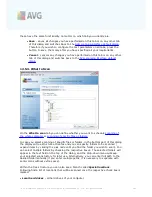
A V G 9 I nternet Sec urity © 2 0 1 0 C opyright A V G T ec hnologies C Z, s .r.o. A ll rights res erved.
2 0 3
·
Locked file
- The reported file is locked, thus cannot be scanned by AVG. This
usually means that some file is constantly being used by the system (
e.g.
swap file
).
12.8. Virus Vault
Virus Vault
is a safe environment for the management of suspect/infected objects
detected during AVG tests. Once an infected object is detected during scanning, and
AVG is not able to heal it automatically, you are asked to decide what is to be done
with the suspect object. The recommended solution is to move the object to the
Virus Vault
for further treatment. The main purpose of the
Virus Vault
is to keep any
deleted file for a certain period of time, so that you can make sure you do not need
the file any more in its original location. Should you find out the file absence causes
problems, you can send the file in question to analysis, or restore it to the original
location.
The
Virus vault
interface opens in a separate window and offers an overview of
information on quarantined infected objects:
·
Severity
- in case you decided to install the
Identity Protection
component
within your
AVG 9 Internet Security
, a graphical identification of the
respective finding severity on a four-levels scale from unobjectionable (
)
up to very dangerous (
) will be provided in this section; and the
information on the infection type (
based on their infective level - all listed
objects can be positively or potentially infected
)
·
Virus Name
- specifies the name of the detected infection according to the
Virus Encyclopedia
(online)
·
Path to file
- full path to the original location of the detected infectious file
·
Original object name
- all detected objects listed in the chart have been
labeled with the standard name given by AVG during the scanning process. In







































